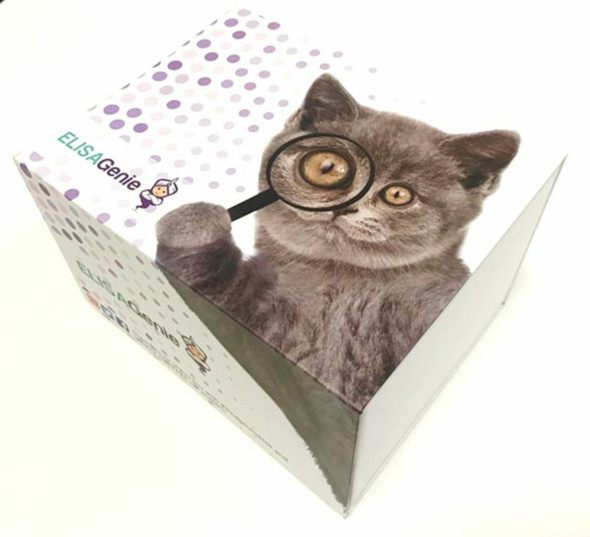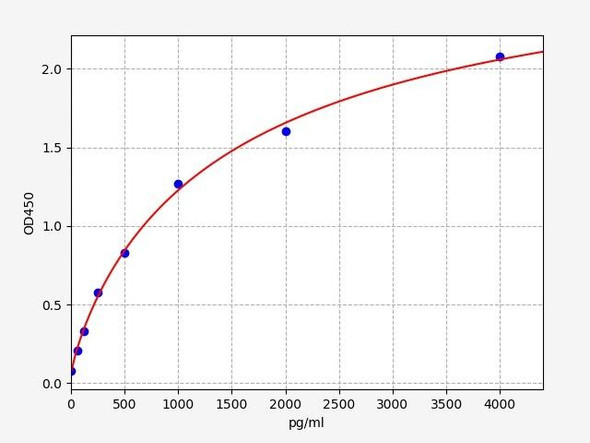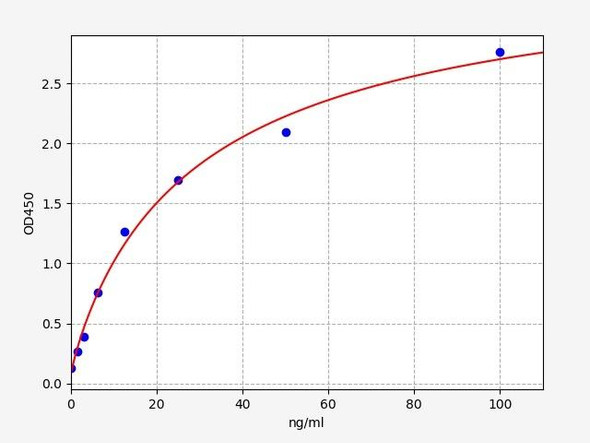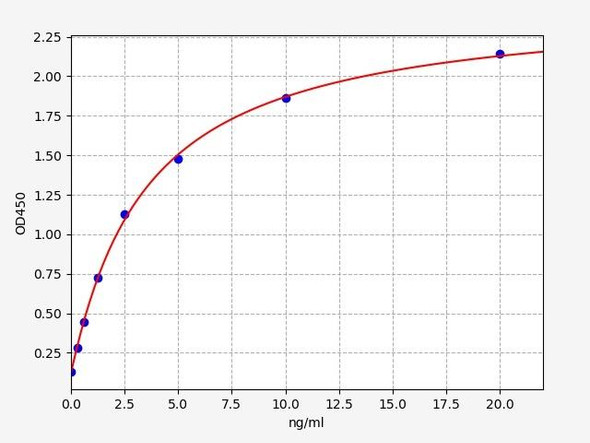Human Cardiovascular ELISA Kits
Human PROC (Protein C) ELISA Kit (HUES02247)
- SKU:
- HUES02247
- Product Type:
- ELISA Kit
- Size:
- 96 Assays
- Uniprot:
- P04070
- Sensitivity:
- 37.5pg/mL
- Range:
- 62.5-4000pg/mL
- ELISA Type:
- Sandwich
- Synonyms:
- PROC1, PC, Autoprothrombin IIA, Blood coagulation factor XIV
- Reactivity:
- Human
- Sample Type:
- Serum, plasma and other biological fluids
- Research Area:
- Cardiovascular
Description
| Assay type: | Sandwich |
| Format: | 96T |
| Assay time: | 4.5h |
| Reactivity: | Human |
| Detection Method: | Colormetric |
| Detection Range: | 62.50-4000 pg/mL |
| Sensitivity: | 37.50 pg/mL |
| Sample Volume Required Per Well: | 100µL |
| Sample Type: | Serum, plasma and other biological fluids |
| Specificity: | This kit recognizes Human PROC in samples. No significant cross-reactivity or interference between Human PROC and analogues was observed. |
This ELISA kit uses Sandwich-ELISA as the method. The micro ELISA plate provided in this kit has been pre-coated with an antibody specific to Human PROC. Standards or samples are added to the appropriate micro ELISA plate wells and combined with the specific antibody. Then a biotinylated detection antibody specific for Human PROC and Avidin-Horseradish Peroxidase (HRP) conjugate are added to each micro plate well successively and incubated. Free components are washed away. The substrate solution is added to each well. Only those wells that contain Human PROC, biotinylated detection antibody and Avidin-HRP conjugate will appear blue in color. The enzyme-substrate reaction is terminated by adding Stop Solution and the color turns yellow. The optical density (OD) is measured spectrophotometrically at a wavelength of 450 nm ± 2 nm. The OD value is proportional to the concentration of Human PROC. The concentration of Human PROC in samples can be calculated by comparing the OD of the samples to the standard curve.
| UniProt Protein Function: | PROC: Protein C is a vitamin K-dependent serine protease that regulates blood coagulation by inactivating factors Va and VIIIa in the presence of calcium ions and phospholipids. Defects in PROC are the cause of thrombophilia due to protein C deficiency, autosomal dominant (THPH3). A hemostatic disorder characterized by impaired regulation of blood coagulation and a tendency to recurrent venous thrombosis. However, many adults with heterozygous disease may be asymptomatic. Individuals with decreased amounts of protein C are classically referred to as having type I protein C deficiency and those with normal amounts of a functionally defective protein as having type II deficiency. Defects in PROC are the cause of thrombophilia due to protein C deficiency, autosomal recessive (THPH4). A hemostatic disorder characterized by impaired regulation of blood coagulation and a tendency to recurrent venous thrombosis. It results in a thrombotic condition that can manifest as a severe neonatal disorder or as a milder disorder with late-onset thrombophilia. The severe form leads to neonatal death through massive neonatal venous thrombosis. Often associated with ecchymotic skin lesions which can turn necrotic called purpura fulminans, this disorder is very rare. Belongs to the peptidase S1 family. |
| UniProt Protein Details: | Protein type:Protease; Apoptosis; EC 3. 4. 21. 69 Chromosomal Location of Human Ortholog: 2q13-q14 Cellular Component: endoplasmic reticulum lumen; Golgi lumen; extracellular region Molecular Function:protein binding; serine-type endopeptidase activity; calcium ion binding Biological Process: cellular protein metabolic process; negative regulation of blood coagulation; blood coagulation; proteolysis; post-translational protein modification; peptidyl-glutamic acid carboxylation; leukocyte migration; negative regulation of apoptosis Disease: Thrombophilia Due To Protein C Deficiency, Autosomal Recessive; Thrombophilia Due To Protein C Deficiency, Autosomal Dominant |
| NCBI Summary: | This gene encodes a vitamin K-dependent plasma glycoprotein. The encoded protein is cleaved to its activated form by the thrombin-thrombomodulin complex. This activated form contains a serine protease domain and functions in degradation of the activated forms of coagulation factors V and VIII. Mutations in this gene have been associated with thrombophilia due to protein C deficiency, neonatal purpura fulminans, and recurrent venous thrombosis. [provided by RefSeq, Dec 2009] |
| UniProt Code: | P04070 |
| NCBI GenInfo Identifier: | 131067 |
| NCBI Gene ID: | 5624 |
| NCBI Accession: | P04070. 1 |
| UniProt Secondary Accession: | P04070,Q15189, Q15190, Q16001, Q53S74, Q9UC55, B4DPQ7 |
| UniProt Related Accession: | P04070 |
| Molecular Weight: | 461 |
| NCBI Full Name: | Vitamin K-dependent protein C |
| NCBI Synonym Full Names: | protein C (inactivator of coagulation factors Va and VIIIa) |
| NCBI Official Symbol: | PROC |
| NCBI Official Synonym Symbols: | PC; APC; PROC1; THPH3; THPH4 |
| NCBI Protein Information: | vitamin K-dependent protein C; prepro-protein C; autoprothrombin IIA; anticoagulant protein C; blood coagulation factor XIV |
| UniProt Protein Name: | Vitamin K-dependent protein C |
| UniProt Synonym Protein Names: | Anticoagulant protein C; Autoprothrombin IIA; Blood coagulation factor XIVCleaved into the following 3 chains:Vitamin K-dependent protein C light chain; Vitamin K-dependent protein C heavy chain; Activation peptide |
| Protein Family: | Vitamin K-dependent protein |
| UniProt Gene Name: | PROC |
| UniProt Entry Name: | PROC_HUMAN |
As the OD values of the standard curve may vary according to the conditions of the actual assay performance (e. g. operator, pipetting technique, washing technique or temperature effects), the operator should establish a standard curve for each test. Typical standard curve and data is provided below for reference only.
| Concentration (pg/mL) | O.D | Average | Corrected |
| 4000 | 2.251 2.287 | 2.269 | 2.216 |
| 2000 | 1.511 1.513 | 1.512 | 1.459 |
| 1000 | 0.908 0.878 | 0.893 | 0.84 |
| 500 | 0.396 0.43 | 0.413 | 0.36 |
| 250 | 0.232 0.204 | 0.218 | 0.165 |
| 125 | 0.155 0.143 | 0.149 | 0.096 |
| 62.50 | 0.094 0.112 | 0.103 | 0.05 |
| 0 | 0.047 0.059 | 0.053 | -- |
Precision
Intra-assay Precision (Precision within an assay): 3 samples with low, mid range and high level Human PROC were tested 20 times on one plate, respectively.
Inter-assay Precision (Precision between assays): 3 samples with low, mid range and high level Human PROC were tested on 3 different plates, 20 replicates in each plate.
| Intra-assay Precision | Inter-assay Precision | |||||
| Sample | 1 | 2 | 3 | 1 | 2 | 3 |
| n | 20 | 20 | 20 | 20 | 20 | 20 |
| Mean (pg/mL) | 189.18 | 548.62 | 1879.79 | 202.95 | 578.76 | 1843.26 |
| Standard deviation | 12.54 | 30.67 | 78.20 | 10.70 | 31.20 | 101.19 |
| C V (%) | 6.63 | 5.59 | 4.16 | 5.27 | 5.39 | 5.49 |
Recovery
The recovery of Human PROC spiked at three different levels in samples throughout the range of the assay was evaluated in various matrices.
| Sample Type | Range (%) | Average Recovery (%) |
| Serum (n=5) | 92-106 | 99 |
| EDTA plasma (n=5) | 86-99 | 92 |
| Cell culture media (n=5) | 92-107 | 98 |
Linearity
Samples were spiked with high concentrations of Human PROC and diluted with Reference Standard & Sample Diluent to produce samples with values within the range of the assay.
| Serum (n=5) | EDTA plasma (n=5) | Cell culture media (n=5) | ||
| 1:2 | Range (%) | 100-117 | 97-114 | 93-104 |
| Average (%) | 106 | 105 | 98 | |
| 1:4 | Range (%) | 89-102 | 78-92 | 87-101 |
| Average (%) | 96 | 85 | 94 | |
| 1:8 | Range (%) | 94-109 | 84-96 | 89-101 |
| Average (%) | 100 | 90 | 94 | |
| 1:16 | Range (%) | 93-105 | 84-97 | 89-102 |
| Average (%) | 99 | 90 | 95 |
An unopened kit can be stored at 4°C for 1 month. If the kit is not used within 1 month, store the items separately according to the following conditions once the kit is received.
| Item | Specifications | Storage |
| Micro ELISA Plate(Dismountable) | 8 wells ×12 strips | -20°C, 6 months |
| Reference Standard | 2 vials | |
| Concentrated Biotinylated Detection Ab (100×) | 1 vial, 120 µL | |
| Concentrated HRP Conjugate (100×) | 1 vial, 120 µL | -20°C(shading light), 6 months |
| Reference Standard & Sample Diluent | 1 vial, 20 mL | 4°C, 6 months |
| Biotinylated Detection Ab Diluent | 1 vial, 14 mL | |
| HRP Conjugate Diluent | 1 vial, 14 mL | |
| Concentrated Wash Buffer (25×) | 1 vial, 30 mL | |
| Substrate Reagent | 1 vial, 10 mL | 4°C(shading light) |
| Stop Solution | 1 vial, 10 mL | 4°C |
| Plate Sealer | 5 pieces | |
| Product Description | 1 copy | |
| Certificate of Analysis | 1 copy |
- Set standard, test sample and control (zero) wells on the pre-coated plate and record theirpositions. It is recommended to measure each standard and sample in duplicate. Note: addall solutions to the bottom of the plate wells while avoiding contact with the well walls. Ensuresolutions do not foam when adding to the wells.
- Aliquot 100 µL of standard solutions into the standard wells.
- Add 100 µL of Sample / Standard dilution buffer into the control (zero) well.
- Add 100 µL of properly diluted sample (serum, plasma, tissue homogenates and otherbiological fluids) into test sample wells.
- Cover the plate with the sealer provided in the kit and incubate for 90 min at 37 °C.
- Aspirate the liquid from each well, do not wash. Immediately add 100 µL of BiotinylatedDetection Ab working solution to each well. Cover the plate with a plate seal and gently mix. Incubate for 1 hour at 37 °C.
- Aspirate or decant the solution from the plate and add 350 µL of wash buffer to each welland incubate for 1-2 minutes at room temperature. Aspirate the solution from each well andclap the plate on absorbent filter paper to dry. Repeat this process 3 times. Note: a microplatewasher can be used in this step and other wash steps.
- Add 100 µL of HRP Conjugate working solution to each well. Cover with a plate seal andincubate for 30 min at 37 °C.
- Aspirate or decant the solution from each well. Repeat the wash process for five times asconducted in step 7.
- Add 90 µL of Substrate Reagent to each well. Cover with a new plate seal and incubate forapproximately 15 min at 37 °C. Protect the plate from light. Note: the reaction time can beshortened or extended according to the actual color change, but not by more than 30min.
- Add 50 µL of Stop Solution to each well. Note: Adding the stop solution should be done inthe same order as the substrate solution.
- Determine the optical density (OD value) of each well immediately with a microplate readerset at 450 nm.






